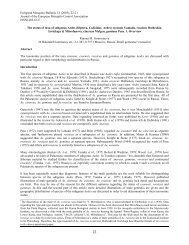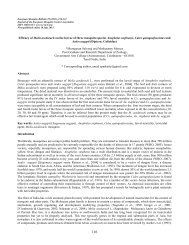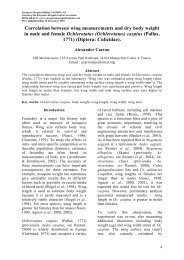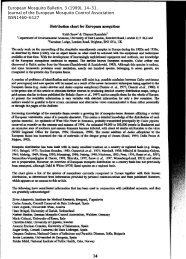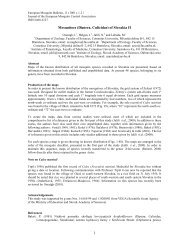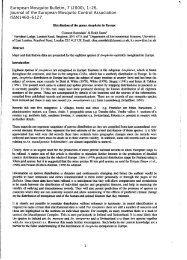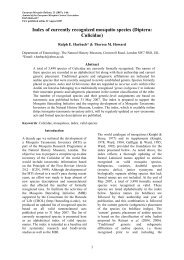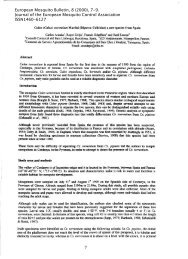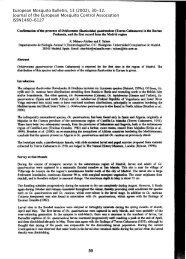22 Distribution and frequency of Culex pipiens and Culex torrentium ...
22 Distribution and frequency of Culex pipiens and Culex torrentium ...
22 Distribution and frequency of Culex pipiens and Culex torrentium ...
You also want an ePaper? Increase the reach of your titles
YUMPU automatically turns print PDFs into web optimized ePapers that Google loves.
quinquefasciatus, whereas AK-78 <strong>and</strong>, at a lower <strong>frequency</strong> AK-53, were typical inpopulations <strong>of</strong> Cx. <strong>torrentium</strong> (Fig 6, Table 5).Every genotype combination provided 100% confidence in discriminating between Cx.<strong>pipiens</strong> <strong>and</strong> Cx. <strong>torrentium</strong> except “78-100”. However, this genotype was rarely observed(with frequencies <strong>of</strong> 0.33% <strong>and</strong> 0.6% respectively in Cx. <strong>pipiens</strong> <strong>and</strong> Cx. <strong>torrentium</strong>: seeappendix). Analysis with the HBDH marker system confirmed this species diagnosis. If bothenzyme marker systems failed in identifying an individual it was removed from the analysis.HBDH showed a high degree <strong>of</strong> species specific allele <strong>and</strong> genotype distribution <strong>and</strong> wasfound to differentiate between Cx <strong>pipiens</strong> <strong>and</strong> Cx. <strong>torrentium</strong> (Table 6, Table 7). Results fromHBDH served as control <strong>of</strong> the AK-marker. The genotype distribution was as in AK, but witha high degree <strong>of</strong> intraspecific polymorphism <strong>and</strong> heterozygosity <strong>of</strong> individual alleles in Cx.<strong>pipiens</strong>. More than 99% <strong>of</strong> the results <strong>of</strong> HBDH reliably distinguished the species. Thegenotypic <strong>and</strong> allelic differentiation <strong>of</strong> the both species is shown in Fig 7 <strong>and</strong> Fig 8.100%90%80%70%60%50%40%30%20%10%0%Cx. <strong>pipiens</strong>Cx. <strong>torrentium</strong>*-66-2525-2525-10025-158100-100100-158100-<strong>22</strong>5158-158158-<strong>22</strong>5<strong>22</strong>5-<strong>22</strong>5100%80%60%40%20%0%Cx. <strong>pipiens</strong>Cx. <strong>torrentium</strong>-6625100158<strong>22</strong>5Fig 7. HBDH genotype distributionFig 8. HBDH allele frequenciesAbundance <strong>of</strong> Cx. <strong>pipiens</strong> <strong>and</strong> Cx. <strong>torrentium</strong>The 96 ovitraps were employed from mid-May to September. <strong>Culex</strong> sp. larvae were recordedin 442 <strong>of</strong> 864 ovitrap collections in the Upper Rhine Valley (Germany). After rearing thelarvae from 333 ovitraps successfully, 2052 specimens were analysed using allozymeelectrophoresis. This r<strong>and</strong>om selection produced 1124 specimens (54.8%) <strong>of</strong> Cx. <strong>pipiens</strong> (<strong>and</strong>given the open nature <strong>of</strong> their aquatic sources almost certainly <strong>of</strong> the nominate biotype) <strong>and</strong>928 (45.2%) <strong>of</strong> Cx. <strong>torrentium</strong> (Table 1.).The species proportion found in 33 artificial <strong>and</strong> natural breeding sites in the study area wassimilar: Of 420 specimens, (59.0%) were Cx. <strong>pipiens</strong> <strong>and</strong> 292 (41.0%) were Cx. <strong>torrentium</strong>.In contrast to these results from larval populations, CO 2 -traps yielded 597 specimens <strong>of</strong> Cx.<strong>pipiens</strong> (96.1% <strong>of</strong> total catch), but only 24 specimens (3.9%) <strong>of</strong> Cx. <strong>torrentium</strong> (Table 1.).Altogether, 621 specimens <strong>of</strong> both species were caught in 189 traps during four seasons in thestudy area.28



